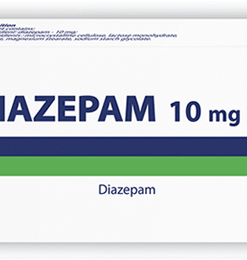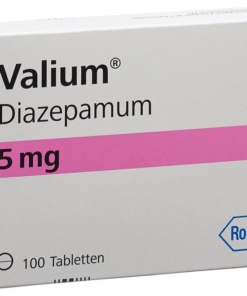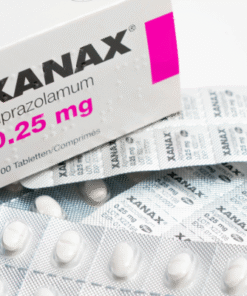Lorazepam (Ativan)
€400.00 – €520.00Preisspanne: €400.00 bis €520.00
What is Lorazepam? – Detailed product guide of antidepressant medications
As experts in antidepressant medications, we would like to introduce you today to an active ingredient that has been used successfully in medicine for decades: lorazepam . This medication belongs to the benzodiazepine class and is primarily used to treat anxiety , sleep problems , and preoperative sedation .
Lorazepam has anxiolytic, sedative, muscle-relaxing, and antispasmodic effects. The 1 mg lorazepam dosage is particularly popular because it offers an ideal balance between efficacy and tolerability.
How does lorazepam work in the body?
Lorazepam exerts its effects in the central nervous system. It enhances the effect of the inhibitory neurotransmitter GABA (gamma-aminobutyric acid) , thereby achieving a general suppression of neuronal activity.
This leads to:
-
Anxiety relief and inner peace
-
Muscle relaxation
-
Calming in states of excitement
-
Sleep promotion
1 mg of lorazepam is considered the standard dose for adults for the short-term treatment of acute symptoms such as panic, insomnia or severe nervousness.
Product specifications of Lorazepam
| Characteristic | Details |
|---|---|
| Product name | Lorazepam |
| Active ingredient | Lorazepam |
| Available strengths | 0.5 mg / 1 mg lorazepam / 2.5 mg |
| Dosage forms | Tablets, drops, injection solution |
| Areas of application | Anxiety, insomnia, preoperative sedation, seizures |
| Duration of action | Medium (half-life approx. 10–20 hours) |
| Onset of effect | 30-60 minutes after ingestion |
| Prescription only | Yes |
When is lorazepam used?
Lorazepam is used medically for:
-
Acute and chronic anxiety disorders 😟
-
Sleep problems , especially difficulty falling asleep 😴
-
Tension before operations or examinations
-
Convulsions or epileptic seizures (eg status epilepticus)
-
Alcohol withdrawal symptoms
The most popular dosage is 1 mg lorazepam , as it works reliably without excessive sedation. For milder symptoms, a lower dose can be started, while more severe conditions may require higher doses—always under medical supervision.
How is Lorazepam taken correctly?
Lorazepam is usually taken orally as a tablet , but in special cases it can also be administered intravenously or sublingually . The exact dosage depends on individual needs.
Recommended dosages:
-
Adults (anxiety): 0.5 mg to 1 mg lorazepam , 2–3 times daily
-
Sleep disorders: 1-2 mg in the evening before going to bed
-
Preoperative sedation: 1-2 mg approximately 1 hour before the procedure
-
Children and the elderly: lower doses under medical supervision
💡 Note: Lorazepam should not be stopped abruptly, especially if taken for a long time – otherwise withdrawal symptoms may occur.
Possible side effects of lorazepam
Like all medications, lorazepam can cause side effects, especially if used improperly or for too long.
Common side effects:
-
Drowsiness / Sedation
-
Dizziness or lightheadedness
-
Concentration problems
-
Muscle weakness
Rare but serious reactions:
-
Paradoxical effects (eg restlessness, aggression)
-
Respiratory depression , especially in combination with alcohol or opioids
-
Risk of addiction with long-term use
👉 Especially in older people, lorazepam 1mg can lead to falls or confusion – close monitoring is important here.
Interactions with other medications
Lorazepam should not be combined with:
-
Alcohol 🍷
-
Painkillers with opioid effects (eg tramadol, morphine)
-
Antidepressants
-
Neuroleptics / antipsychotics
-
other sedatives or sleeping pills
These combinations increase the risk of respiratory depression , sedation and impaired consciousness .
Frequently Asked Questions (FAQs)
What exactly does lorazepam do?
Lorazepam calms the central nervous system, relieves anxiety, promotes sleep and relaxes muscles – thanks to its effect on the GABA neurotransmitter.
How quickly does lorazepam work?
The effect begins within 30 to 60 minutes after ingestion and lasts up to 12 hours , depending on the dose and metabolism .
How long can I take Lorazepam?
Lorazepam is intended for short-term use —usually a maximum of 2–4 weeks . Longer use increases the risk of addiction.
What is the difference between Lorazepam 1mg and other dosages?
Lorazepam 1 mg is the common dose for treating anxiety. It offers a good balance between efficacy and freedom from side effects. Lower doses (eg, 0.5 mg) are suitable for more sensitive patients.
Can I take lorazepam with alcohol?
No. Combining lorazepam with alcohol can lead to dangerous side effects such as respiratory arrest and unconsciousness – avoid it at all costs!
Customer reviews ⭐⭐⭐⭐⭐
💬 Tanja S. from Berlin:
„I was given 1mg of lorazepam for exam anxiety at short notice – it really calmed me down without making me feel „spaced out.“ Very helpful!“
💬 Max R. from Cologne:
„I had trouble sleeping for weeks – with Lorazepam, I was finally able to sleep through the night again. However, I only take it when needed.“
💬 Ines M. from Vienna:
„I was given Lorazepam to prepare for dental surgery – it calmed me down and everything went smoothly. I didn’t experience any side effects.“
Why Antidepressant Medication Is Your Partner for Lorazepam
With antidepressant medications, you’ll receive more than just information—you’ll get real understanding. We explain medications like lorazepam , lorazepam 1mg , and other dosages in clear, human language. Our content includes:
-
Medically based
-
Understandable for laypeople
-
SEO-optimized
-
Patient-oriented
Our goal is to help you use medications , safely effectively, and responsibly.
Legal notice
Lorazepam is a prescription drug and should only be taken under medical supervision. The content provided here is for informational purposes only and is not a substitute for medical advice. Always consult your doctor or pharmacist if you have any questions.
| Menge | 2mg/90 pills, 2mg/180 pills |
|---|
Schreibe die erste Rezension für „Lorazepam (Ativan)“ Antworten abbrechen
Ähnliche Produkte
Kaufen Sie Benziodiazepine
Kaufen Sie Benziodiazepine
Kaufen Sie Benziodiazepine
Kaufen Sie Benziodiazepine
Kaufen Sie Benziodiazepine
Kaufen Sie Benziodiazepine
Kaufen Sie Benziodiazepine
Kaufen Sie Benziodiazepine












Rezensionen
Es gibt noch keine Rezensionen.